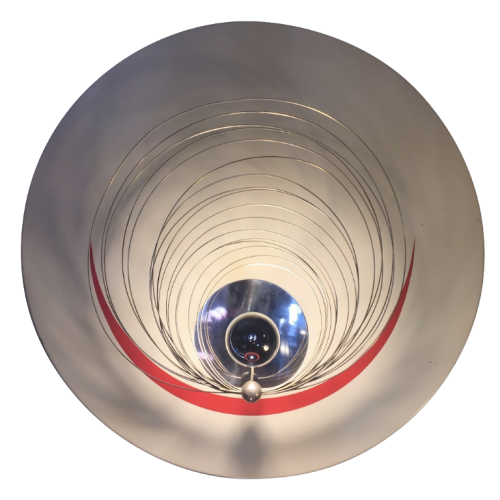- Creator / Artiste/ Designer:Attributed to Georges Vantongerloo (1886-1965)
- Signature / Monogramme:No (attributed to)
- Period:XXème siècle / 1940 - 1960
- Dimensions (H x W x D):23,6 inch x 23,6 inch x 5,5inch
- Weight:2 Kg
- Condition:Excellent
- Styles:Kinetic Art / Op'Art ( Optic Art )/ Modern Art / Abstract Art
- Material:Painted Metal Steel / Inox / Chrome
-
Price:On request
Georges Vantongerloo:
Around 1900, he studied at the Royal Academy of Fine Arts in Brussels and the Royal Academy of Fine Arts in Antwerp.
He is an important pioneer of abstract painting.
He exhibited for the first time his paintings in The Hague in 1917 at the Cercle Hollando-Belge and will meet Jules Schmalzigaug who introduced him to modern art and became closely linked to the magazine and artistic movement De Stijl with Theo van Doesburg, Robert van 't Hoff, Vilmos Huszár, Anthony Cook, Piet Mondrian and Jan Wils.
He creates abstract works that are purely geometric. especially lattice-shaped compositions.
Unlike Mondrian, it gradually shifts from a dominance of straight lines and angles to painting other geometric shapes such as circles and ovals.
Vantongerloo also introduced into the De Stijl Group most of the exact sciences.
In 1931, with Theo van Doesburg, Naum Gabo and Antoine Pevsner, he founded the Abstraction-Creation movement in Paris and conducted research on spatial and volumetric proportions and applied them to "spherical constructions" or "mass interrelations".
He will be the first to use the aesthetic principles of neoplasticism to sculpture.
In the mid-1940s, he used increasingly curved lines in a series of very fine sculptures with curved bars in iron, nickel and silver. He calls these works Endless Space or Cosmic Element. These are wire sculptures that suggest space and dynamics.
In 1936, he took part in the exhibition Cubism and abstract art at the Museum of Modern Art in New York, then at the Galerie de Berri in Paris and in 1949 at the Kunsthaus Zurich with Max Bill.
His work is closely linked to the "Zero Group".
His works can be found in the largest modern art museums in Europe.
